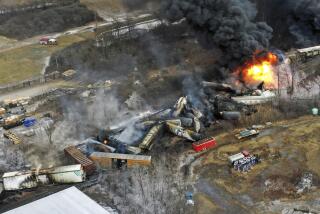Victory Over SP Claimed by Coalition
Leaders of four Southeast cities and the grass roots group UNO say political pressure from their new coalition has led Southern Pacific Transportation Co. to reduce the number of times its trains block streets for long periods.
Coalition members were pleased last week when the company, which operates Southern Pacific Railroad, was fined $8,500 after pleading no contest to five misdemeanor counts of illegally blocking intersections earlier this year. The plea came the day before trial was scheduled to begin in Whittier Municipal Court.
“They seem to be taking us seriously now--that in itself is a victory,” said Suzanne Seager, co-chairman of the recently formed Southeast chapter of the United Neighborhoods Organization, which has worked in concert with officials from Norwalk, Santa Fe Springs, Pico Rivera and Huntington Park.
Southern Pacific was fined the maximum of $1,000 on each count plus a penalty assessment to cover court procedural and administrative costs, said Deputy Dist. Atty. Rob Miller.
The most serious charge stemmed from an April incident in Pico Rivera, when a 7,000-foot train blocked north-south traffic across the city for 48 minutes. A state Public Utilities Commission regulation prohibits trains from blocking intersections for longer than 10 minutes unless there are mechanical problems or other unforeseeable difficulties.
In exchange for the no-contest plea, the district attorney’s office agreed to drop one count and not file charges for two other incidents under investigation, said Miller.
Financial, Public Risk
“I think they’ve realized that the risk they run by not taking the incidents as seriously as we all do in the community is both financial and a public one,” he said.
S. James Otero, a lawyer for Southern Pacific, said the plea bargain did not represent a retreat on behalf of the company.
“Some of these cases we were clearly responsible for, but they’re dismissing one charge we thought was defensible,” Otero said. “I think we have resolved the problems that have been occurring.”
Last month in a separate case, the district attorney’s office for the first time charged two Southern Pacific trainmen in a stoppage that blocked traffic for two hours in the unincorporated Florence-Walnut Park area.
Even though fewer problems have occurred in recent weeks, city officials who have been dealing with Southern Pacific since the 1970s say they are skeptical of the railroad’s commitment.
“With more cities involved, the railroad is going to feel a little more pressure,” said Don Powell, city manager of Santa Fe Springs, where trains have created long delays three or four times each month.
“But if there’s a let-up of the pressure, I’m almost sure this situation will revert back to the way it was,” Powell said.
Monitoring System
UNO’s strategy is to develop a communication system for monitoring train delays throughout the Southeast area, Seager said. The system is designed to ensure that the railroad does not reduce delays by shifting them from one area to another, she said.
UNO-Southeast made the train problems the first focus of its neighborhood activism. The church-based group brought together--for the first time--city officials, railroad officials, lawyers from the district attorney’s office, PUC representatives, sheriff’s deputies and representatives of 11 Catholic parishes in 16 Southeast cities.
About 150 people attended an August UNO meeting, during which Southern Pacific officials were confronted with dramatic testimony about children forced to climb between train cars on their way to school and other hazards caused by train delays.
That night, Southern Pacific refused to accept UNO’s seven-point proposal for improving the situation but agreed to hold discussions about the problem. Since then, the railroad has restricted the length of some trains and equipped its crews with radios that allow communication with the Santa Fe Railroad line, which shares some area tracks, said Thomas Hunt of the PUC.
In Norwalk, City Traffic Engineer Carmen Gencusa said the train problem has improved since he met with Southern Pacific officials in June. Trains moving through the area have been shortened to about 5,000 feet, he said, allowing them to cross an intersection in six or seven minutes. The Pico Rivera sheriff’s station also reports shorter trains and fewer delays.
Gencusa credits a change on the part of Southern Pacific management as well as a change in Norwalk’s tactics.
“We took our story to the newspapers,” he said. “The attitude the railroad had was that we were trespassing on their right of way. We had a hard road to haul.”
UNO met Sept. 30 with officials of the railroad, Norwalk, Santa Fe Springs, Pico Rivera and Huntington Park during which Southern Pacific again pledged its cooperation in dealing with the problem, Seager said. Before that, there was no formal line of communication.
More to Read
Sign up for Essential California
The most important California stories and recommendations in your inbox every morning.
You may occasionally receive promotional content from the Los Angeles Times.










